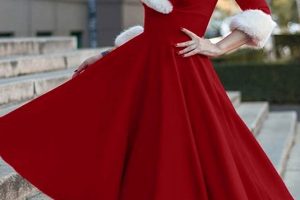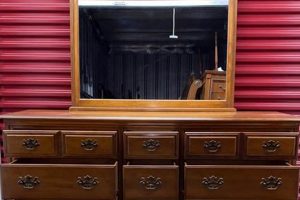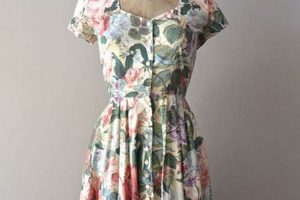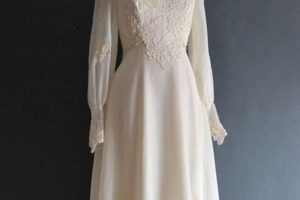A classic aesthetic for bridal attire often involves garments from past eras characterized by understated elegance. These gowns typically feature clean lines, minimal embellishments, and timeless silhouettes, prioritizing comfort and grace over elaborate ornamentation. For example, a 1950s tea-length dress with a fitted bodice and a full skirt, constructed from lightweight fabric like crepe or chiffon, exemplifies this style.
Selecting such attire offers several advantages. It provides an opportunity to express individuality and stand apart from contemporary trends. Furthermore, these garments often represent sustainable and ethically conscious choices, promoting reuse and reducing textile waste. Historically, this understated approach reflected diverse social values, ranging from wartime austerity to a rejection of ostentatious displays of wealth.
The following sections will examine specific decades and designs that embody the essence of unadorned bridal fashion, exploring fabrics, cuts, and accessories that complete the picture of refined, timeless wedding day style.
Guidance on Attaining an Understated, Era-Inspired Bridal Look
The following outlines key considerations for individuals pursuing a minimalist, time-honored wedding aesthetic. Adherence to these principles will facilitate the selection of a bridal ensemble that reflects both personal style and historical accuracy.
Tip 1: Fabric Selection Prioritization: Prioritize natural, lightweight fabrics. Silk, linen, and cotton blends offer breathability and drape well, enhancing the garment’s overall simplicity and comfort. Avoid heavily embellished or stiff materials that detract from the desired effect.
Tip 2: Silhouette Simplification: Opt for classic, unadorned silhouettes. A-line, sheath, or empire waist dresses are often suitable choices. These styles minimize excessive detailing and emphasize the bride’s natural form.
Tip 3: Ornamentation Restraint: Exercise restraint in the application of embellishments. Should embellishments be desired, consider subtle additions like delicate lace trim or understated beading. Overly ornate or elaborate detailing can undermine the minimalist aesthetic.
Tip 4: Color Palette Adherence: Maintain a consistent color palette. Off-white, ivory, or champagne hues are commonly associated with vintage-inspired bridal wear. Consider the undertones of the chosen fabric to ensure color harmony.
Tip 5: Accessory Minimalism: Complement the dress with understated accessories. A simple veil, delicate jewelry, or classic shoes will enhance the overall look without overwhelming the garment’s design.
Tip 6: Era Research: Conduct thorough research on specific historical periods. Understanding the fashion trends and cultural norms of the desired era will inform the selection of appropriate dress styles and accessories.
Tip 7: Professional Alterations: Secure professional alterations to ensure a precise and flattering fit. A well-fitted garment enhances the overall appearance and contributes to the desired level of sophistication.
By focusing on fabric, silhouette, embellishments, color, accessories, era research, and fit, individuals can successfully achieve a timeless, understated bridal look that reflects both their personal style and a refined aesthetic.
The subsequent section will delve into specific examples of how these tips translate into practical application, showcasing various designs that capture the essence of understated bridal elegance across different eras.
1. Timeless silhouettes
Timeless silhouettes are a defining characteristic of the understated, era-inspired bridal aesthetic. These shapes, having proven their enduring appeal across decades, inherently contribute to the simplicity and elegance associated with such garments. The selection of a silhouette is a foundational decision, exerting considerable influence over the overall appearance and contributing to the garment’s ability to transcend fleeting trends. For instance, the A-line silhouette, prevalent in numerous eras, from the 1950s to the 1970s, achieves a balance between fitted and flowing, offering a universally flattering shape without excessive ornamentation.
The impact of a carefully chosen silhouette extends beyond mere aesthetics; it also affects comfort and practicality. Simplified shapes typically allow for greater freedom of movement and are constructed from lighter materials, enhancing wearability. Conversely, excessively complex or structured silhouettes can restrict movement and necessitate heavier fabrics, potentially undermining the desired simplicity. Consider the empire waist gown, popularized in the early 19th century and revived in subsequent decades. Its high waistline and flowing skirt offer a comfortable and elegant option, emphasizing the wearer’s figure without relying on elaborate embellishments or restrictive corsetry. The result is a silhouette that is inherently simple yet undeniably impactful.
In summary, timeless silhouettes are not merely an element of a “vintage wedding dress simple”; they are a core component, dictating the overall aesthetic, affecting comfort, and contributing to the garment’s enduring appeal. Understanding the properties and historical context of various silhouettes allows for informed choices that achieve a balance between simplicity, elegance, and personal expression, ensuring the bridal attire embodies a refined and understated aesthetic.
2. Understated Fabrics
The selection of fabric is paramount in achieving the minimalist aesthetic central to unadorned, era-inspired bridal wear. The material’s propertiesits texture, weight, drape, and sheendirectly influence the garment’s overall appearance and contribute significantly to its understated elegance. Prioritizing restraint in fabric choice is crucial for realizing the desired effect.
- Lightweight Natural Fibers
Fabrics such as silk crepe, chiffon, and fine cotton blends provide a delicate drape and subtle texture, avoiding the heaviness or stiffness often associated with more elaborate materials. These fibers allow for fluid movement and enhance the garment’s overall comfort. For instance, a bias-cut silk crepe dress from the 1930s exemplifies how a lightweight fabric can create a sophisticated yet understated silhouette. The use of such materials reinforces the emphasis on simplicity and natural elegance.
- Minimal Surface Interest
Fabrics with minimal surface embellishments, such as subtle weaves or matte finishes, contribute to the understated nature of the garment. Excessive ornamentation, like heavy beading or elaborate lace, detracts from the desired simplicity. A plain silk satin, for example, offers a luxurious feel without overwhelming the design with extraneous details. The absence of overt embellishment allows the focus to remain on the garment’s silhouette and the bride’s natural beauty.
- Color Palette Restraint
The color of the fabric also plays a role in maintaining an understated aesthetic. Soft, muted tones like ivory, champagne, or off-white are commonly associated with vintage bridal wear. Bold or saturated colors can undermine the desired simplicity, drawing undue attention to the fabric itself. A gentle ivory hue in a lightweight linen, for instance, conveys a sense of timeless elegance without being visually overpowering. The careful consideration of color contributes to the overall harmony and balance of the garment.
- Textural Subtlety
Fabrics with subtle textures, such as a fine crepe or a delicate weave, add visual interest without compromising the minimalist aesthetic. These subtle textures provide depth and dimension to the garment without resorting to overt embellishment. A gown crafted from a finely textured silk, for example, offers a tactile experience that enhances the overall elegance of the design. The understated textural quality complements the simple silhouette and refined color palette.
In conclusion, the selection of understated fabrics is integral to achieving the desired simplicity and elegance associated with unadorned, era-inspired bridal wear. By prioritizing lightweight natural fibers, minimal surface interest, color palette restraint, and textural subtlety, the garment’s aesthetic remains refined and timeless, allowing the bride’s personal style to shine through without being overshadowed by excessive embellishment or ostentatious materials. These fabrics provide a foundation for a bridal look that is both sophisticated and effortlessly graceful.
3. Minimal ornamentation
Minimal ornamentation is a defining characteristic of the unadorned, era-inspired bridal aesthetic, contributing directly to the perception of “vintage wedding dress simple.” The absence of excessive embellishment allows the garment’s silhouette, fabric, and wearer to take precedence, embodying a sense of refined elegance.
- Emphasis on Silhouette and Fabric
When ornamentation is minimal, the inherent qualities of the dress’s cut and material are highlighted. A sheath dress from the 1960s, crafted from fine crepe, exemplifies this principle. The clean lines and smooth drape of the fabric become the focal point, showcasing the design’s inherent beauty without distraction from beads, lace, or other embellishments. This approach emphasizes the garment’s structure and material quality.
- Focus on the Wearer
Reducing ornamentation ensures the wearer remains the central element of the bridal ensemble. An overly adorned dress can overwhelm the individual, obscuring her features and personal style. A simple A-line gown from the 1950s, devoid of excessive detailing, allows the bride’s natural beauty and personality to shine through, enhancing her presence on her wedding day.
- Timelessness and Versatility
Dresses with minimal ornamentation often possess a greater sense of timelessness. Trends in embellishment fluctuate, and dresses heavily reliant on specific detailing can appear dated quickly. A simple slip dress from the 1930s, for instance, maintains its elegance regardless of current fashion trends. Furthermore, the lack of elaborate decoration allows for greater versatility in styling and accessorizing.
- Cost-Effectiveness and Sustainability
Garments with minimal ornamentation are frequently more cost-effective than their heavily embellished counterparts. The reduced labor and material costs associated with simpler designs contribute to their affordability. Additionally, choosing a simply designed garment often aligns with sustainable practices, as it reduces the demand for intricate and often environmentally damaging embellishment processes.
The emphasis on minimal ornamentation in the context of “vintage wedding dress simple” is not merely an aesthetic choice; it represents a conscious decision to prioritize the garment’s core elements, highlight the wearer, promote timelessness, and potentially embrace cost-effectiveness and sustainability. This approach results in a bridal ensemble that is both elegant and enduring.
4. Era appropriateness
Era appropriateness functions as a foundational pillar in the pursuit of a “vintage wedding dress simple.” The successful embodiment of this aesthetic hinges on adherence to the sartorial conventions and design sensibilities of the chosen historical period. The causal relationship is clear: disregard for era-specific details undermines the authenticity and impact of the overall look. For instance, incorporating distinctly 1980s puffed sleeves onto a gown styled after the minimalist designs of the 1930s would be incongruous, disrupting the visual harmony and historical accuracy.
The importance of era appropriateness extends beyond mere aesthetics. It signifies a respect for historical context and an understanding of the social and cultural forces that shaped fashion trends. Selecting a dress that genuinely reflects a specific decade allows for a deeper connection to the past and a more nuanced expression of personal style. A practical example lies in choosing a tea-length dress with a full skirt for a 1950s-themed wedding, emulating the characteristic silhouette and hemlines of that era, or opting for a bias-cut gown of the 1930s if seeking a pre-war Hollywood glamour.
A thorough understanding of era appropriateness, thus, is not merely a stylistic consideration but a practical necessity. It necessitates research into prevailing fabrics, silhouettes, embellishments, and accessories of the targeted decade. This knowledge ensures the final bridal ensemble is not simply a vague approximation of “vintage wedding dress simple” but a faithful and elegant representation of a specific historical aesthetic. Successfully navigating this element elevates the entire bridal presentation from a pastiche to a cohesive and meaningful statement.
5. Flattering fit
A flattering fit constitutes a fundamental element of the “vintage wedding dress simple” aesthetic. The connection is not merely associative but rather causal: even the most exquisitely designed vintage gown fails to achieve its intended elegance if the fit is suboptimal. A garment that is too loose loses its intended shape and drape, while one that is too tight can distort the silhouette and compromise comfort. Therefore, achieving a flattering fit is not an optional consideration but a mandatory prerequisite for realizing the inherent beauty of simple, era-inspired bridal wear. For example, a 1960s shift dress, known for its clean lines, only achieves its intended minimalist chic when properly tailored to skim the body without clinging or constricting movement.
Securing a flattering fit often necessitates professional alterations. Vintage garments, unlike contemporary clothing, may not conform to modern sizing standards, and the bride’s body shape may deviate from the original design’s intended proportions. The expertise of a skilled seamstress is crucial for adjusting the garment to the individual’s unique physique. Consider a 1940s bias-cut gown, designed to drape elegantly over the body. If the garment does not fit precisely, the bias cut can accentuate imperfections rather than create a smooth, flattering line. Careful alterations, such as adjusting the shoulder seams, side seams, and hemline, can transform a poorly fitting dress into a figure-enhancing masterpiece.
In summary, a flattering fit is not simply a desirable attribute but an indispensable component of the “vintage wedding dress simple” look. Without a well-tailored garment, the intended elegance and timelessness of the dress are irrevocably compromised. The investment in professional alterations is therefore a crucial step in ensuring that the bridal ensemble achieves its full potential, resulting in a cohesive and flattering presentation of understated, era-inspired bridal style. The challenge lies in finding a seamstress with expertise in vintage garment construction and alteration techniques, emphasizing the need for thorough research and careful selection.
6. Subtle color
In the context of “vintage wedding dress simple,” subtle color transcends mere aesthetic preference; it functions as a crucial element in achieving the desired timeless elegance. The deployment of restrained hues amplifies the inherent simplicity of the design, prevents visual clutter, and reinforces the garment’s connection to historical precedent.
- Enhancement of Silhouette
Subtle color palettes, such as ivory, champagne, or soft ecru, allow the dress’s silhouette to take prominence. A stark white can often flatten the garment’s dimensions, whereas understated tones create depth and accentuate the subtle nuances of the design. For instance, a 1930s bias-cut gown in a light champagne shade showcases the fabric’s drape and movement more effectively than a similar gown in bright white, which tends to emphasize the surface rather than the form.
- Era-Appropriate Harmony
Many vintage eras favored muted tones over brilliant whites. Edwardian-era dresses, for instance, often featured creamy off-whites, while 1950s bridal wear frequently incorporated blush or pale gold accents. Adhering to these historically accurate color schemes enhances the authenticity of the vintage aesthetic. A careful selection of subtle colors contributes to a convincing representation of the chosen era, avoiding jarring anachronisms that disrupt the overall effect.
- Complementary to the Wearer
Subtle colors often prove more universally flattering than pure white. Ivory, for example, softens the complexion and complements a wider range of skin tones. The choice of a subtle hue allows the wearer’s natural features to remain the focal point, rather than being overshadowed by an overly stark or dominating color. This ensures the bride’s overall appearance is harmonious and balanced.
- Minimization of Visual Noise
In “vintage wedding dress simple,” the aim is to minimize visual distractions. Bold or vibrant colors inherently draw attention, undermining the desired understated effect. Subtle colors, in contrast, blend seamlessly, allowing the dress to complement rather than compete with the surroundings and accessories. This restraint in color choice reinforces the overall sense of quiet elegance and timelessness.
The considered use of subtle colors is thus integral to realizing the goals of “vintage wedding dress simple.” It enhances the garment’s silhouette, maintains era-appropriate harmony, complements the wearer, and minimizes visual distractions. These factors combine to create a bridal ensemble that embodies refined elegance and enduring style, demonstrating that color choice is far from a superficial detail but a crucial element in achieving the desired aesthetic.
7. Restrained accessories
The principle of restrained accessories forms an essential component within the framework of “vintage wedding dress simple.” The selection and application of accessories directly impact the overall aesthetic, influencing whether the ensemble achieves a cohesive representation of understated elegance or devolves into visual discord. Overly elaborate or numerous accessories detract from the simplicity of the dress itself, undermining the intended effect. For example, a delicate 1930s silk slip dress, designed for its fluid lines and unadorned beauty, would be diminished by pairing it with a heavily jeweled tiara and multiple strands of pearls. Instead, a simple headpiece, such as a delicate comb or a streamlined headband, would complement the dress without overwhelming it.
The impact of accessory restraint extends beyond mere visual harmony. It reflects a conscious prioritization of the dress and the wearer. Overly ornate accessories often compete for attention, drawing focus away from the garment’s intrinsic qualities and the bride’s natural features. A more judicious approach emphasizes the dress’s lines and details, allowing the wearer’s personality and beauty to take center stage. A practical application of this principle might involve choosing a single, significant piece of jewelry, such as a vintage brooch or a pair of classic earrings, rather than a profusion of smaller items. The aim is to enhance, not overwhelm, the overall composition.
In summary, the concept of restrained accessories is inextricably linked to the successful realization of “vintage wedding dress simple.” It represents a deliberate choice to prioritize simplicity, enhance the dress’s inherent qualities, and allow the wearer’s personality to shine through. Successfully implementing this principle demands careful consideration of each accessory’s impact on the overall ensemble and a commitment to prioritizing understated elegance over ostentatious display. The challenge lies in finding accessories that complement the dress without overshadowing it, a task that requires careful selection and a discerning eye.
Frequently Asked Questions
The following addresses common inquiries regarding unadorned, era-inspired bridal wear, providing clarity on key considerations and misconceptions.
Question 1: What defines “vintage wedding dress simple?”
The term refers to bridal attire sourced from past eras, characterized by understated elegance, minimal embellishments, and timeless silhouettes. These garments prioritize clean lines, quality fabrics, and a focus on the bride rather than elaborate ornamentation.
Question 2: Does “vintage wedding dress simple” necessarily mean inexpensive?
While the aesthetic favors restraint, the price depends on factors like fabric quality, designer reputation (if applicable), condition, and rarity. A simply designed gown made from fine silk can be more expensive than a heavily embellished modern dress using synthetic materials.
Question 3: How does one ensure a genuine “vintage wedding dress simple” rather than a modern imitation?
Authenticity can be verified by examining labels, construction techniques, fabric composition, and design details. Researching historical fashion trends and consulting with vintage clothing experts is advisable.
Question 4: What eras are most associated with the “vintage wedding dress simple” aesthetic?
The 1930s (slip dresses), 1950s (tea-length gowns), and 1960s (shift dresses) are particularly well-suited. However, elements of simplicity can be found in various periods, depending on individual interpretation and styling.
Question 5: Can a “vintage wedding dress simple” be altered to fit current body types and preferences?
Alterations are often necessary, but significant modifications can compromise the garment’s integrity and historical accuracy. Prioritizing dresses that closely match the desired fit minimizes the need for extensive changes.
Question 6: Are there specific accessories that complement a “vintage wedding dress simple?”
Accessories should echo the dress’s understated elegance. Simple veils, delicate jewelry (pearls or understated metalwork), and classic shoes are appropriate choices. Avoid overly ornate or contemporary accessories that clash with the vintage aesthetic.
In summary, achieving a successful “vintage wedding dress simple” look requires a nuanced understanding of historical fashion, fabric quality, and design principles. A focus on authenticity, fit, and restrained styling ensures a timeless and elegant bridal presentation.
The subsequent section will explore resources for sourcing unadorned, era-inspired bridal attire, providing guidance on reputable vendors and online platforms.
Conclusion
The preceding exploration has established “vintage wedding dress simple” as more than a mere aesthetic preference. It represents a conscious choice to prioritize timeless elegance, understated beauty, and historical context within bridal attire. Through careful consideration of silhouette, fabric, ornamentation, era appropriateness, fit, color, and accessories, individuals can achieve a refined and enduring bridal presentation that transcends fleeting trends. The selection of such attire signifies a commitment to quality, sustainability, and a personal connection to the sartorial traditions of the past.
The pursuit of unadorned, era-inspired bridal wear offers an opportunity to express individuality and celebrate enduring style. As the fashion landscape continues to evolve, the principles of “vintage wedding dress simple” remain relevant, providing a framework for creating a bridal ensemble that is both elegant and meaningful. Continued exploration and appreciation of historical fashion trends will further enhance the ability to craft truly timeless and sophisticated bridal looks, solidifying the lasting influence of this refined aesthetic.







